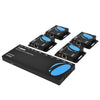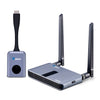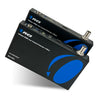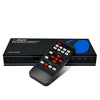Do You Need an HDMI eARC For Dolby Atmos?

HDMI eARC and Dolby Atmos are two technologies that have become popular in recent years. They're designed to create home theater experiences that rival cinema experiences. To give you a short description, HDMI eARC is a technology that allows for higher-quality audio to be transmitted over HDMI cables, while Dolby Atmos is an audio format that adds height channels to traditional surround sound.
However, the question remains. Do you really need HDMI eARC for Dolby Atmos? Let’s dive in and find out.
First off, let’s define each technology deeper.
What is HDMI eARC?
HDMI eARC stands for High-Definition Multimedia Interface (HDMI) Enhanced Audio Return Channel (eARC). It is an updated version of the HDMI ARC technology that has been in use for several years already. The main purpose of both HDMI ARC and eARC is to allow audio to be sent from a display device, such as a TV, back to a sound system or a soundbar using the same HDMI cable that is being used for video.
The difference between ARC and eARC is that the latter has a higher bandwidth. This allows for higher-quality audio to be transmitted. At the same time, eARC also supports more audio formats, including lossless audio such as Dolby Atmos, Dolby TrueHD, and DTS-HD Master Audio. HDMI eARC is typically used in home theater systems, including soundbars, AV receivers, and TVs.
What is Dolby Atmos?
Dolby Atmos is a sound technology that takes traditional surround sound to the next level. It’s designed to create a more immersive and realistic audio experience where sound can come from any direction, just like how it is in real life. When applied to films, this means that you can hear everything happening in a scene. From the subtlest background noises to the most explosive action sequences, you’ll hear it with incredible clarity and detail.
How does Dolby Atmos work?
Dolby Atmos technology uses object-based sound, which means that individual sounds are treated as separate objects, rather than being part of a fixed channel. This allows for more precise placement and movement of sound and creates a more dynamic and realistic audio experience. It also supports a wider range of audio formats, including lossless audio, which means that you can enjoy the highest possible quality of sound.
Now, the golden question: Do you need HDMI eARC for Dolby Atmos?
The short answer would be no. Dolby Atmos does not require you to use HDMI eARC. Dolby Atmos can be transmitted through HDMI eARC’s older brother, the HDMI ARC. However, it is important to note that using HDMI eARC can, and probably will, improve the quality of audio and allow for more audio formats to be transmitted. For the best possible Dolby Atmos experience, using an HDMI eARC is still highly recommended.
What are the benefits of using HDMI eARC for Dolby Atmos?
-
Higher-quality audio transmission
One of the main benefits of using HDMI eARC for Dolby Atmos lies in its name. HDMI eARC allows for a more enhanced audio quality to be transmitted. For the best experience, lossless audio formats like Dolby Atmos require more bandwidth than the regular ARC can provide, making eARC necessary for higher audio formats to be transmitted without compression. Also, eARC supports more audio formats in general, so you’re sure to enjoy a wider range of content with higher-quality audio.
- Higher supported bitrate
Another advantage of using eARC for Dolby Atmos is that it supports higher bitrates than ARC. This helps prevent any unwanted audio lags that might occur. Having higher bitrates means that you get to experience a more immersive digital experience. Bitrates are also especially important for gaming, where even a small amount of audio lag can have a big impact on the experience. With eARC, you can certainly enjoy Dolby Atmos audio without having to worry about any delays or lags.
How to set up HDMI eARC for Dolby Atmos
Setting up your HDMI eARC for Dolby Atmos is relatively simple. Although the exact steps may vary depending on your specific TV and sound system, this general guide will help you get started.
- Before you consider getting an HDMI eARC soundbar or AVR for your home theater setup, make sure that your TV supports this technology. To check, you may want to look over your device’s manual or do a quick search online.
- Once you’re sure that your device can support it, connect your sound system to your TV using an HDMI cable.
- On your TV, navigate to the audio settings menu and enable HDMI eARC.
- On your sound system, make sure that eARC is also enabled.
- Test your new setup by playing any Dolby Atmos-enabled content.
It’s important to note that not all HDMI cables are created equal. For your setup to work properly, use the best eARC HDMI cable for home theaters. Typically, these HDMI cables are labeled as “Ultra High Speed”. You can also look at the cable specifications to find out if it supports ARC or eARC.
If you have an older sound system that does not readily support eARC, there is a workaround. For your sound system to work with eARC technology, you can get an HDMI ARC/eARC Digital Audio Converter. This allows you to fully enjoy the ultimate sound quality that Dolby Atmos brings, without having to spend too much on a newer soundbar or home theater setup.
To conclude, while you don’t technically need HDMI eARC technology for Dolby Atmos, using it will certainly improve the quality and performance of your audio – resulting in a much more pleasurable watching experience. Remember, for the best possible Dolby Atmos experience, using an HDMI eARC enabled device is highly recommended. HDMI eARC’s ability to transmit lossless audio and its support for a wider range of audio formats makes it the future of high-quality audio transmission.
Also, setting up HDMI eARC for Dolby Atmos is as easy as connecting a cable to a speaker. With the right equipment and cables, you can enjoy a home theater experience that truly rivals the cinema. So whether you’re a movie buff, an audiophile, or a serious gamer, you should consider investing in an HDMI eARC sound system to take your audio experience to the next level.
If you’re ready to gather everything you need for your HDMI eARC and Dolby Atmos home setup, feel free to browse through our shop. You may also find the HDMI ARC/eARC Digital Audio Converter that we mentioned earlier by clicking this link. For other types of HDMI distribution devices that you might need such as HDMI matrix switches or splitters, you may also find them there. All information you’ll need to make a well-informed decision is readily available in each product listing. Make sure you read through the descriptions and specifications to make sure that it’s exactly what you need.
Do you want to read more HDMI-related articles and blogs? Click here to visit our blog!





























